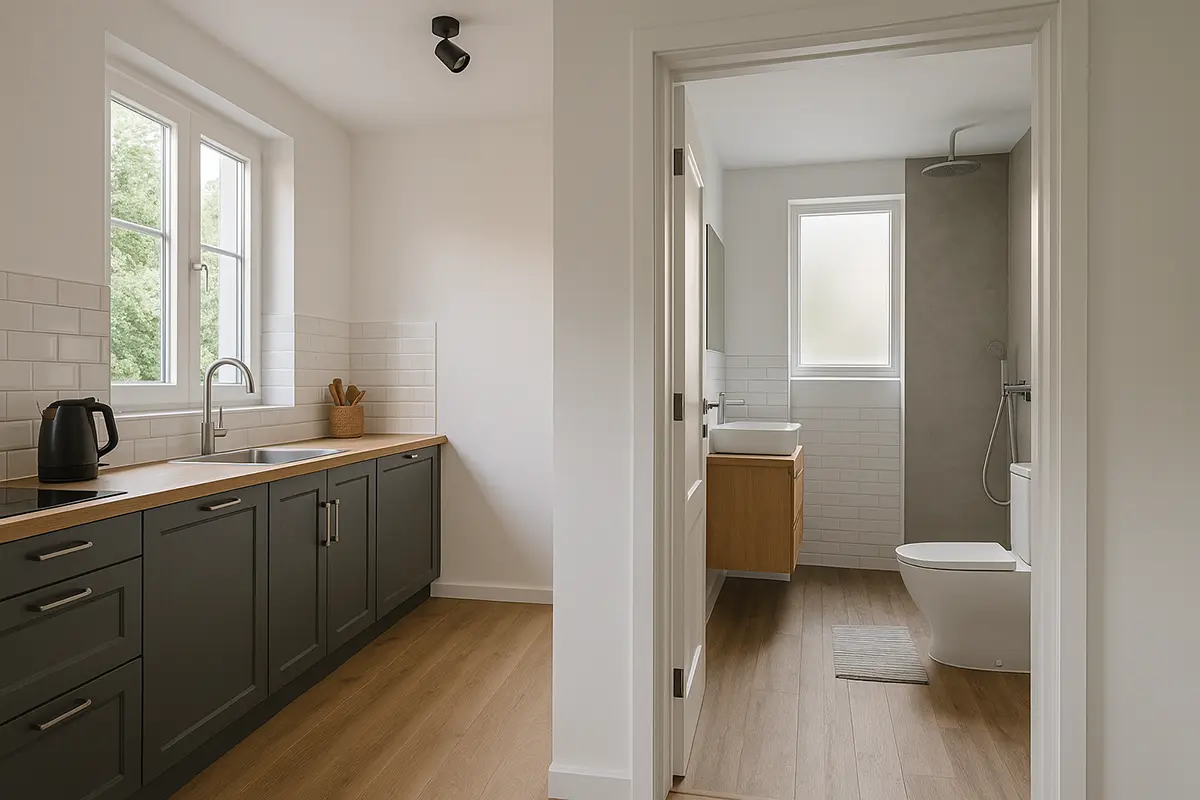A worker and an architect applying thermal insulation during the construction of a house. Thermal insulation is crucial for enhancing energy efficiency in our homes. In this article, we will explore its impact on walls, windows, and roofs, as well as the significance of polystyrene as an insulating material. Additionally, we will uncover key strategies for achieving a well-insulated space, the most efficient types of insulators, and their contribution to home sustainability. Furthermore, we will examine the benefits of thermal insulation for the health and well-being of its inhabitants. Keep reading at laquintafachada.com!
The Impact of Thermal Insulation on Energy Efficiency
Thermal insulation is essential for ensuring energy efficiency in any home.There are various key areas where thermal insulation plays a crucial role: walls, windows, roofs, and the use of polystyrene as an insulating material.
Thermal Insulation in Walls
Walls are one of the primary sources of heat loss in a home. Proper thermal insulation in walls prevents heat transfer to the outside during winter and from the outside to the inside during summer. This helps maintain a pleasant indoor temperature and reduces the need for heating or cooling systems, resulting in lower energy consumption.
Thermal Insulation in Windows
Windows are often another weak point in terms of thermal insulation. Poorly insulated windows allow heat to escape during winter and enter during summer. It is crucial to have windows with double or triple glazing and properly sealed profiles to prevent these heat losses.
Thermal Insulation in Roofs
Roofs also significantly impact energy efficiency. Proper thermal insulation in the roof prevents heat from accumulating in summer and escaping in winter. This contributes to maintaining a stable temperature inside the home and reducing the load on air conditioning systems.
The Importance of Polystyrene in Thermal Insulation
When it comes to insulating materials, polystyrene stands out for its efficiency and versatility. This material has excellent thermal properties and can be used in different areas of the home, such as walls, roofs, and floors. Polystyrene is resistant to moisture and the passage of time, ensuring durable and effective insulation.
Keys to Achieving a Well-Insulated Space
Achieving proper thermal insulation in our home is essential to ensure comfort and energy efficiency. Here are some key considerations for achieving adequate insulation:
- Assess your home’s needs: Every house is different, so it’s important to assess your home’s specific characteristics, such as climate, orientation, presence of drafts, and construction materials. This will help you determine which areas need more focus on insulation.
- Insulate the walls: Walls are one of the main sources of heat loss in a home. Use quality insulating materials to reduce this loss, such as expanded polystyrene, rock wool, or plasterboard with integrated insulation.
- Pay attention to windows: Windows can be responsible for significant heat loss. Opt for double or triple glazing with thermal break and frames made of PVC or aluminum with thermal break to minimize heat transfer.
- Don’t forget the insulation in the ceilings: Ceilings are also a critical area in terms of insulation. Use insulating materials for sloped or flat roofs, such as sandwich panels, rigid foams, or mineral wools, to prevent heat leaks.
- Seal joints and cracks: Ensure that all joints and cracks in your home are properly sealed. Using appropriate sealants helps prevent air infiltration and unnecessary heat loss. Control ventilation: It’s important to maintain good ventilation in the home to prevent moisture buildup and improve indoor air quality. Opt for controlled ventilation systems that allow fresh air in without compromising thermal insulation. With these keys, you can achieve a well-insulated space that provides thermal comfort and energy savings. Remember, the right choice of materials and proper design are crucial for optimal results in terms of thermal insulation in your home.
Most Efficient Thermal Insulators
To achieve optimal thermal insulation in the home, it’s important to choose the right materials. Here are some of the most efficient insulators:
- Fiberglass: This material is widely used due to its high heat retention capacity and excellent fire resistance. Additionally, it’s easy to install and does not degrade over time.
- Rock wool: Known for its fire resistance and sound insulation properties, rock wool also provides good thermal insulation. It’s effective in maintaining controlled temperatures inside the home.
- Polyurethane: This material is characterized by its high thermal insulation capacity. It’s ideal for use in small areas or tight spaces due to its ease of application in foam form.
- Extruded polystyrene: With a closed structure and resistance to moisture, extruded polystyrene offers excellent thermal resistance. It’s an ideal option for roofs and walls.
- Polyisocyanurate: This type of insulator has excellent insulation capacity and is very fire-resistant. It’s commonly used in roof and wall insulation systems. These are just a few examples of efficient thermal insulators that can be used in home construction or renovation. It’s important to consider the specific needs of each project and choose the most suitable material to ensure good thermal insulation in the home.
The Importance of Thermal Insulation in Home Sustainability
Thermal insulation plays a fundamental role in the sustainability of the home. It not only allows us to maintain a comfortable indoor temperature but also contributes to reducing energy consumption and minimizing environmental impact.
With proper energy efficiency, thanks to thermal insulation, we can significantly reduce the demand for heating and cooling in our home. This leads to lower energy consumption, which not only helps us save on our bills but also contributes to reducing greenhouse gas emissions and slowing climate change.
Thermal insulation acts as a barrier that prevents heat transfer to the outside in winter and keeps heat out in summer. This maintains a more stable temperature inside the home, reducing the need to constantly use heating or air conditioning systems.
Additionally, good thermal insulation in the home offers other sustainability benefits. On the one hand, it improves thermal comfort, allowing us to feel more comfortable in our own home throughout the year. On the other hand, by reducing the need to use mechanical climate control systems, we decrease noise pollution and improve indoor air quality.
It’s important to note that thermal insulation is not only focused on walls and roofs but also plays a significant role in windows. Having double-glazed windows and profiles with thermal break helps optimize the energy efficiency of our home even further.
Benefits of Thermal Insulation for the Health and Well-being of Home Inhabitants
Thermal insulation in the home not only provides greater energy efficiency and economic savings but also offers numerous benefits for the health and well-being of its inhabitants. Here are the most notable advantages:
- Increased thermal comfort: Good thermal insulation helps maintain a stable indoor temperature, avoiding sudden temperature changes and creating a more comfortable and welcoming environment in the home. This reduces stress and improves rest.
- Noise reduction: Thermal insulation also serves as sound insulation, reducing the transmission of external noises into the home. This is especially beneficial in urban areas or near high-traffic roads, where noise can negatively affect our quality of life.
- Moisture regulation: Good thermal insulation prevents the condensation of moisture on the interior surfaces of walls, ceilings, and windows. This helps prevent humidity problems, such as mold and fungi, which can cause allergies and respiratory issues.
- Energy savings: A well-insulated home requires less effort in climate control, leading to lower energy consumption and, consequently, significant long-term economic savings. Additionally, by reducing energy demand, we contribute to environmental conservation.
- Health and well-being: Maintaining a constant and pleasant temperature at home positively impacts our general health and well-being. A warm environment in winter and a cool one in summer promote a good mood, proper rest, and a sense of well-being in our daily lives.
Error: Contact form not found.




